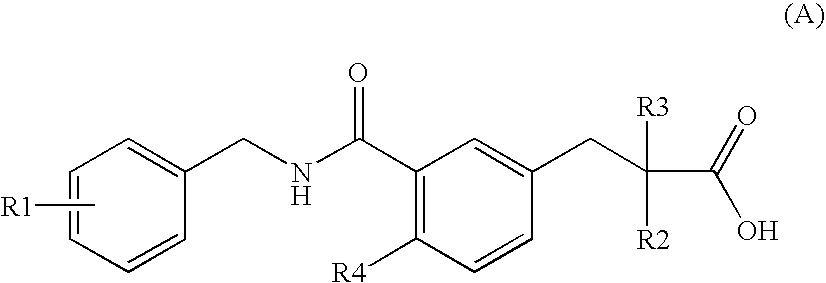(2S)-2-ethylphenylpropionic acid derivative
a technology of phenylpropanoic acid and derivatives, which is applied in the direction of drug compositions, peptide/protein ingredients, metabolic disorders, etc., can solve the problems of inability to offer medicinal drugs, unstable metabolic and chemical properties of endogenous unsaturated fatty acid derivatives, etc., and achieve potent agonistic activity on ppar, different structure, and potent effect in vivo
- Summary
- Abstract
- Description
- Claims
- Application Information
AI Technical Summary
Benefits of technology
Problems solved by technology
Method used
Image
Examples
example 1
[3(2S),4R]-4-Benzyl-3-(2-{3-[3-(N-{[4-(3,4-difluorophenoxy)phenyl]methyl}carbamoyl)-4-methoxyphenyl]methyl})butanoyloxazolidinone-2-one
[0017]
[0018] To a solution of compound (500 mg, 1.37 mmol) of Referential example 1 in ethanol (10 mL) was added hydrazine-hydrate (137 mg, 2.74 mmol), and the mixture was refluxed for 2 hours. The reaction mixture was filtered and the filtrate was concentrated under reduced pressure. Ethyl acetate was added to the residue, which was washed with 2 mol / L aqueous solution of sodium hydroxide and brine. The ethyl acetate layer was dried over anhydrous magnesium sulfate and then concentrated. To the residue were added dichloromethane (15 mL), [3(2S),4R]-3-[2-ethyl-3-(4-methoxy-3-{N-[(4-fluorophenoxyphenyl)methyl]carbamoyl}phenyl)propanoyl]-4-benzyloxazolidine-2-one (542 mg, 1.37 mmol) and N-ethyl-N′-3-dimethylaminopropylcarbodiimide hydrochloride (395 mg, 2.06 mmol) in turn, and the mixture was stirred for 14 hours at room temperature. After concentrati...
examples 2 through 8
[0020] Through similar process to Example 1, compounds listed in following Table 1 were obtained.
TABLE 1ExampleR1R2R323-F5-FH32-F3-FH42-F4-FH52-F5-FH62-F6-FH73-F4-F5-F83-CF35-CF3H
>
[3(2S),4R]-4-Benzyl-3-(2-{3-[3-(N-{[4-(3,5-difluorophenoxy)phenyl]methyl}carbamoyl)-4-methoxyphenyl]methyl})butanoyloxazolidinone-2-one
[0021]1H-NMR (400 MHz, CDCl3, δ): 0.93 (3H, t, J 7.3), 1.74-1.81 (1H, m), 2.58 (1H, dd, J 9.3, 13.2), 2.80 (1H, dd, J 6.8, 13.7), 3.06-3.15 (2H, m) 3.91 (3H, s), 4.01-4.18 (3H, m), 4.65 (2H, d, J 5.9), (4.66-4.70 (1H, m), 6.45-6.54 (3H, m), 6.92 (1H, d, J 8.3), 6.98 (2H, d, J 8.8), 7.07 (2H, d, J 6.3), 7.22-7.28 (3H, m), 7.34 (2H, d, J 8.8), 7.43 (1H, dd, J 2.4, 8.3), 8.11 (1H, d, J 2.4), 8.18 (1H, brt).
>
[3(2S),4R]-4-Benzyl-3-(2-{3-[3-(N-{[4-(2,3-difluorophenoxyl)phenyl]methyl}carbamoyl)-4-methoxyphenyl]methyl})butanoyloxazolidinone-2-one
[0022]1H-NMR (400 MHz, CDCl3, δ): 0.92 (3H, t, J 7.3), 1.52-1.62 (1H, m), 2.57 (1H, dd, J 9.3, 13.2), 2.80 (1H, dd, J 6.8, 13.7), 3.0...
example 9
(2S)-2-{[3-(N-{[4-(3,4-Difluorophenoxy)phenyl]methyl}carbamoyl)-4-methoxyphenyl]methyl}butyric acid
[0028]
[0029] To a solution of compound (545 mg, 0.867 mmol) of Example 1 in tetrahydrofuran (5 mL) was added water (1 mL), which was cooled to 0° C. To this were added 30% aqueous hydrogen peroxide (411 mg, 3.63 mmol) and 1 mol / L aqueous solution of lithium hydroxide (1.45 mL) in turn, and the mixture was stirred for 2 hours at 0° C. To the reaction mixture was added a 64% solution of sodium hydrogensulfite (590 mg) in water (2 mL), and the mixture was stirred for 30 minutes at 0° C. The reaction mixture was brought to pH 3 with 3 mol / L hydrochloric acid, which was extracted with ethyl acetate. The ethyl acetate layer was washed with brine, dried over anhydrous magnesium sulfate, and then concentrated. The residue was purified by silica gel column chromatography (hexane:ethyl acetate=4:1→3:2) to afford 299 mg of white powdery title compound. Yield 73%.
[0030] Mp: 118-120° C.
[0031]1H-...
PUM
| Property | Measurement | Unit |
|---|---|---|
| Electrical conductance | aaaaa | aaaaa |
| Molar density | aaaaa | aaaaa |
| Molar density | aaaaa | aaaaa |
Abstract
Description
Claims
Application Information
 Login to View More
Login to View More - R&D
- Intellectual Property
- Life Sciences
- Materials
- Tech Scout
- Unparalleled Data Quality
- Higher Quality Content
- 60% Fewer Hallucinations
Browse by: Latest US Patents, China's latest patents, Technical Efficacy Thesaurus, Application Domain, Technology Topic, Popular Technical Reports.
© 2025 PatSnap. All rights reserved.Legal|Privacy policy|Modern Slavery Act Transparency Statement|Sitemap|About US| Contact US: help@patsnap.com



